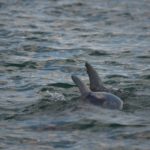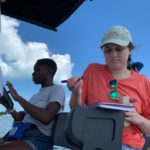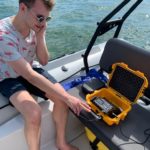The Sea of Abaco: Day 3
Finally, we found dolphins!
Today we all had our fingers crossed for dolphin sightings! The harbour master (Tom) had told us the day before that a dolphin had been sighted within the harbour. So, group 1 (Julie, Tristan, Rosie, Le’Andra and Emily) started the search there. We scanned the harbour systematically searching for dolphins, with no luck. But just after we received a radio call of a sighting of dolphins north of our location, we got a radio call from Tom saying there were two dolphins feeding in the harbour, in the same section where our boat had been docked. We quickly turned around, and immediately continued scanning with binoculars to find these dolphins. Success! We found a mother and calf feeding in the muddy waters of the harbour. The mother is named Roxy (ID Tt105) and was first sighted in 1992. Her calf has been sighted once before by Charlotte and Diane and is now thought to be 2-3 years old.
We then got to work to record data for this sighting. The data collected will be part of Charlotte and Diane’s photo ID work tracking the Abaco dolphin population and Grace’s undergraduate thesis (Grace is one of the 4th year honours students on this trip from University of St Andrews). Photo ID was undertaken by Charlotte who used a high-quality camera to take close-up shots of the dolphins’ dorsal fins (fin on their back). These dolphins collect nicks and scratches throughout their lives which are unique to them, so photo IDs can be used to identify individual animals. These marks appear as the animals grow older, typically the more boisterous males will have more marks, but Roxy has some pretty impressive nicks/notches, which makes her very memorable. The calf has also picked up a few nicks since the last time Charlotte and Diane photographed them. These nicks will help with identifying this dolphin once it is fully weaned and no longer with their mother all the time. Tristan also helped by taking underwater videos with his GoPro which may be able to be used to sex the calf.
For the acoustic data we deployed a towed hydrophone over the port side of our boat. The hydrophone was connected to an amplifier and a recorder. The time in hours, minutes and seconds was noted when the recording started. This is very important in field work when doing photo ID and acoustic surveys simultaneously, so they can easily be linked. We were able to listen to the sounds the hydrophone was picking up through a speaker connected to the recorder(pictured below). We were very excited to hear pulses, echolocation clicks and whistles during the encounter. These are all typical signals of bottlenose dolphins. This was Le’Andra’s and Emily’s first-time listening to dolphin sounds in real time, they were both captivated by their vocal repertoire.
While we listened to the dolphins, we were also taking visual observation notes. Diane and Le’Andra took notes for BMMRO, which included oceanographic and behavioural information. Emily, Tristan and Rosie, with guidance from Julie, noted behavioural observations as and when they happened. These included the direction the dolphins were travelling, their location in relation to the boat, if the two dolphins were surfacing together and when we heard the dolphins vocalising through the recorder. We noted time to the minute whenever new observations were made. This was the first time for most of us sampling in the field and we found it to be more challenging than expected, but exceptionally rewarding. We chose to note everything to get an understanding of field notetaking. We later discussed more efficient ways we can sample these amazing dolphins!
After we had collected lots of data from the mother-calf pair while they were feeding, travelling and socialising we decided to head north to see if we could find more dolphins! We travelled to Whale Cay and a few other barrier islands, but sadly we were out of luck! As the wind was beginning to pack up, we headed back to the harbour to swap out boat teams.
Group 2 (Vincent, India, Grace, Jasmine, Sari) headed back out on the boat for the afternoon shift, where they decided to head south. Sadly, no dolphins were sighted, however they did find a nurse shark and turtles! The groups spirits remained high with the thought of more dolphin sighting trips to come. They all loved seeing the south of the Sea of Abaco which they had not seen before.
To round of a fantastic day, Jasmine made us an amazing Massaman curry, with vegan and gluten free curry paste she had taken with her from the Scotland! Lastly, some of us saw a rocket launch from Cape Canaveral, Florida, which was very exciting. Vincent and Julie must be lucky because they also saw one launch when they visited in January!
Written by Emily McCloskey (University of St. Andrews)
- The mother-calf pair spotted in Marsh Harbour marina. The adult female is Roxie, a resident bottlenose dolphin well-known by BMMRO and locals alike. Her calf was first spotted before Hurricane Dorian, and seems to be doing well.
- Students Le’Andra (left) and Emily (right) noting encounter and recording data for the dolphins spotted in the harbour.
- Tristan listens to the dolphins for vocalisations via the hydrophone deployed in the water.


